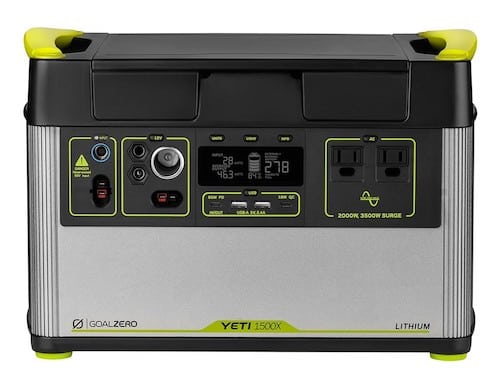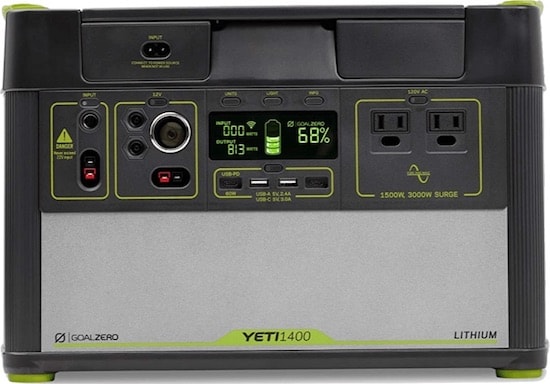When the power goes out, the main backup system you want to have is a solar generator with a lot of power.
One of the most trusted brands out there is Goal Zero, and they officially released the Yeti 1500X on August 17th, 2020.
The Goal Zero Yeti 1500X is a 46 lb solar generator with 1,516Wh of battery capacity. As the successor to the Yeti 1400 Lithium, its improvements include an increased solar input (600W max), MPPT charge controller, and a strengthened AC inverter (2,000W continuous, 3,500W surge).
This model can also be paired with the Yeti App, which Goal Zero made to give users easy access to their solar generators’ functions and data.

All of these features are improvements compared to the Yeti 1500X’s predecessor, the Yeti 1400 Lithium.
The 1400 Lithium looks nearly identical to the 1500X, but its internals have been modified to produce a system that performs better in all major solar generator categories, including:
- Solar input
- Battery capacity
- AC inverter rating
- Charge controller type
The following is an in-depth comparison of the 1500X and the 1400 Lithium.
| Model | Yeti 1500X | Yeti 1400 Lithium |
|---|---|---|
| Image | 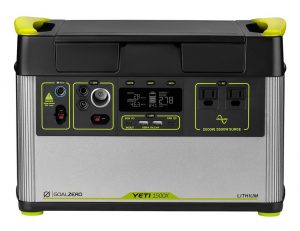 | 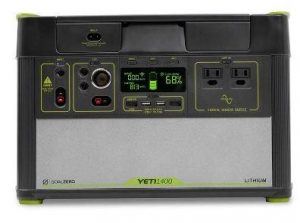 |
| Weight | 45.64 lbs (20.7 kg) | 43.7 lbs (19.8 kg) |
| Dimensions | 15.25 x 10.23 x 10.37 in (38.74 x 25.98 x 34.54 cm) | 10.1 x 15.3 x 10.4 in (25.7 x 28.9 x 26.4 cm) |
| Battery Chemistry | Li-ion NMC | Li-ion NMC |
| Battery Capacity | 1,516Wh (10.8V, 140.4Ah) | 1,425Wh (10.8V, 132Ah) |
| Cycle Life | 500 Cycles to 80% capacity | 500 cycles to 80% capacity |
| Charge Controller Type | MPPT | PWM |
| Output Ports | (2) 120V AC outlets (2,000W continuous, 3,500W surge) (2) USB-A ports: 5V, up to 2.4A (12W max), regulated (1) USB-C port: 5-12V, up to 3.0A (18W max), regulated (1) USB-C PD port: 5-20V, up to 3.0A (60W max), regulated (2) 6mm Ports: 12V, up to 10A (120W max), regulated (1) 12V car port: 12V, up to 13A (160W max), regulated (1) 12V Power Pole Port: 12V, up to 30A (360W max), regulated | (2) 120V AC outlets (1,500W continuous, 3,000W surge) (2) USB-A ports: 5V, up to 2.4A (12W max), regulated (1) USB-C port: 5V, up to 3.0A (15W max), regulated (1) USB PD port: 5V, 12V, 20V up to 3.0A (60W max) (2) 6mm Ports: 12V, up to 10A (120W max) (1) 12V car port: 12V, up to 10A (120W max) (1) 12V Power Pole Port: 12V, up to 20A (240W max) |
| Input Ports | (1) Charging Port (8mm): 14-50V, up to 10A (150W max) (1) Power Pole Charging Port: 14-50V, up to 50A (600W max) | (1) Charging Port (8mm): 14-22V, up to 10A (120W max) (1) Power Pole Charging Port: 14-22V, up to 30A (360W max) |
| Charge Times | Wall Charger: 14 Hours Maximum Input (600W solar panels): 3-6 Hours Boulder 200 Briefcase (200W): 9-18 Hours Boulder 200 Briefcase x2 (400W): 4-8 Hours Boulder 200 x3 (600W): 3-6 Hours | Wall Charger: 25 Hours Maximum Input (360W solar panels): 5-10 Hours Boulder 200 Briefcase (200W): 11-22 Hours Boulder 200 Briefcase x2 (400W): 5-10 Hours |
| Warranty | 24 months | 24 months |
Yeti 1500X – Main Differences from the Yeti 1400 Lithium
The Yeti 1400 Lithium is no longer sold by Goal Zero. The 1400 along with the 400 Lithium, 1000 Lithium, and 3000 Lithium were replaced by the Yeti X series of power stations from the company.
Below I highlight the specific improvements made to the Yeti 1500X compared to the older Yeti 1400 Lithium.
AC Inverter Differences
The 1500X comes with an inverter rated for 2,000W continuous and 3,500W surge. This improvement is very significant because you can now power a lot more equipment than the Yeti 1400.
The 1400 is rated for 1,500W continuous and 3,000W surge. It may not seem like a big change at first, but 500 watts can power a lot of necessities when in a pinch.
Larger Battery in the Yeti 1500X
At 1,516Wh, the 1500X and has a larger battery but similar basic makeup as the Yeti 1400 Lithium, both using a lithium-ion NMC battery. The 91Wh increase is a step above the 1,425Wh of its predecessor, but it’s not a significant jump in capacity.
To put the increased battery size in perspective, the Sherpa 100AC is one of the largest power banks offered by Goal Zero and it has 94.7Wh of battery.
Faster Wall Charging
The Yeti 1400 charges from the wall in approximately 25 hours.
This number has been reduced to only 14 hours for the Yeti 1500X. This is an amazing feat of engineering that brings the capabilities of this generator to be more versatile than ever before.
MPPT Charge Controller – Engineered Into the Yeti 1500X
There are a lot of great improvements to the 1500X, but one of the often-overlooked ones is its charge controller.
People who know solar generators well will know what this is, but for the average person, this is gold for this machine.
The Yeti 1400 has a PWM charge controller with low battery protection, but the Yeti 1500X’s MPPT controller allows for much faster charging via solar panels. Goal Zero claims that with their own solar panels, you will see a 30% more efficient charge via their MPPT technology.
In basic terms, this means that power from the solar panel will be able to convert about 30% more power into the solar generator’s battery at any given time via its MPPT.
Yeti 1500X Solar Input – Massively Improved
Yet another massive improvement from the Yeti 1500X is its ability to attract up to 600 watts of solar power into its system at any given time.
This allows for up to 5x faster charging speeds than the included wall adapter, making it easier to power up your generator after depleting its charge.
Regulated Ports Featured in the Yeti 1500X
There are three ports that are now regulated for the Yeti 1500X – the USB-C PD port, 12V car port, and the High Power port (Anderson Powerpole).
Why is this important? Having regulated ports is a security measure to make sure that whatever is being charged or powered is getting the exact power required for the device to work properly.
Without regulated ports, certain equipment could run at a less effective rate than it is normally capable of.
Similar: Your Next Solar Generator – The Complete Guide
The Yeti Mobile Application Comes With the Yeti 1500X
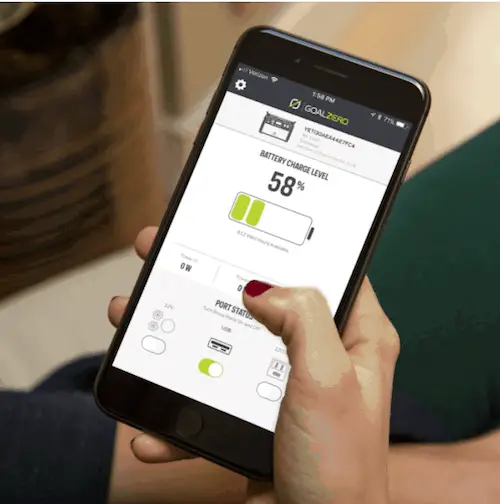
With the Yeti App, you can review power-tracking history, turn ports on and off from your mobile device, and employ different battery modes specific to your needs. The current models that utilize the App are the Yeti 1400 Lithium, Yeti 3000 Lithium, Yeti 1500X, Yeti 3000X, and Yeti 6000X.
This app is unique to Goal Zero and is rare to see amongst other current solar generator brands.
The only other solar generator company to my knowledge that has an application for their product is EcoFlow, and the app is currently only designed for the R600 solar generator.
The Yeti App also has power-tracking history, which allows you to see how much power you’ve used throughout the past day, week, etc.
This is great because you will be able to set specific power modes to your generator so it correlates to patterns of power you’re using throughout each day.
This is mostly for people that are using their solar generators on a consistent basis, but the power modes can apply to anyone using their generator with the app.
Goal Zero’s current Yeti App modes are:
- Performance – Using the battery to its full extent
- Battery Saver – Conserving battery life for essentials
- Balanced – A mix between “Performance” mode and “Battery Saver” mode
- Custom – Tailored to your own needs
These modes can be very beneficial for several occurrences including power outages, running certain electronics like the TV, refrigerator, etc., and much more.
Aspects of the Yeti 1500X That Could Use Improvement
Two AC Outlets in the Yeti 1500X
There are only two AC outlets on the Yeti 1500X, which is not ideal for a powerful system like this one.
For example, the EcoFlow Delta 1300 has a similar battery size as the 1500X but has six AC ports.
This is not ideal because several lights, chargers, and other electronics need AC ports to function.
Of course, an easy solution is to get a powerstrip, but it would have been nice to see at least three to four AC outlets on this generator.
The Yeti 1500X’s AC Outlets Are Very Close Together
The outlets on the 1500X are very close together. If someone is looking to charge their batteries for their camera or something similar, the charging unit for the camera that connects to the AC outlet may be too wide and may cover the other outlet.
This would render the other AC port useless. Nevertheless, this problem could also be solved with a powerstrip.
The Yeti 1500X Is Heavier Than the Yeti 1400 Lithium
The Yeti 1500X weighs 46 lbs, which is two pounds heavier than its predecessor, the Yeti 1400 Lithium. The additional battery capacity and improved internal technology are the main reasons for this increase in weight.
To enhance portability, both the 1400 Lithium and 1500X have a pair of handles for two people to hoist it up together.
Some examples of similar solar generators include the Bluetti EB150, which has the same battery capacity as the Yeti 1500X, but it weighs 38 pounds.
The EcoFlow Delta 1300, at 1,260Wh of battery capacity (240Wh less than the 1500X), weighs only 30 pounds.
Even though the Yeti 1500X is not a massive solar generator like the Yeti 3000 Lithium, it still would be nice to see it come with a roll cart to make it more portable.
At a Cost of $2,000, the Yeti 1500X Is Expensive

At $1,999.95, the 1500X is one of the most expensive solar generators for its size.
There is a premium to pay for this generator, but it is built with high quality in mind. Being in the off-grid industry for over ten years, Goal Zero probably understands its customers better than any of its competitors.
This allows them to create products that solve the majority of their customers’ pain points when it comes to portable power.
However, to give you some perspective on the costs of similar solar generators, below I list some similar models along with their pricing.
Price Comparison – Yeti 1500X vs. Similar Solar Generators
With several medium-large solar generators to choose from, here are a few examples to compare pricing:
- Yeti 1500X: $2,000 (1,516Wh)
- Yeti 1400 Lithium: $1,900 (1,425Wh)
- EcoFlow Delta 1300: $1,199 (1,260Wh)
- Bluetti EB150: $1,299 (1,500Wh) *BEST VALUE*
- Jackery 1000: $1,000 (1,002Wh)
- Inergy Flex: $1,500 (1,069+Wh)
- Point Zero Energy Titan: $3,000 (2,000+Wh)
Each solar generator listed has a similar battery capacity (within 500Wh) to the Yeti 1500X.
As you can see from the examples, only one solar generator (Titan) is more expensive, but it also has 500Wh more battery than the 1500X.
For more details comparing the 1500X and 1400 Lithium, I have a YouTube video analysis below that you may find valuable.
Similar: Bluetti EB150 vs EcoFlow Delta 1300 – Which Solar Generator is Best?
Recommendations – Buy the Yeti 1500X or Choose Another Brand?
The Yeti 1500X has several advanced features that make it one of the best solar generators for its size. However, you can find similar solar generators that cost $500-$1,000 less. For example, the Bluetti EB150 shares the same battery capacity as the Yeti 1500X but costs $700 less.
If you like Goal Zero and have bought other products and enjoy them, then this product is for you if you like it and have use for it.
Besides that, there are several other solar generator models to choose from that will save you hundreds of dollars.
My video analysis of the 1500X may give you a better understanding of how this system works (along with my opinions on this model!).
Continue Reading:
Solar Generators Made in the USA – List of Companies and Models
Top 7 Solar Panel Battery Banks – A Battle for Power
Solar Panel Installation – Step-By-Step for Home and RV

